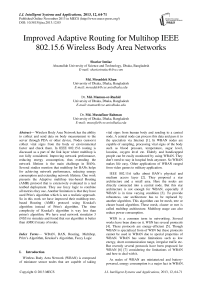Improved Adaptive Routing for Multihop IEEE 802.15.6 Wireless Body Area Networks
Автор: Shariar Imtiaz, Md. Mosaddek Khan, Md. Mamun-or-Rashid, Md. Mustafizur Rahman
Журнал: International Journal of Intelligent Systems and Applications(IJISA) @ijisa
Статья в выпуске: 12 vol.5, 2013 года.
Бесплатный доступ
Wireless Body Area Network has the ability to collect and send data on body measurement to the server through PDA or other device. Nodes (sensors) collect vital signs from the body or environmental factor and check them. In IEEE 802.15.6 routing is discussed as a part of the link layer where multihop is not fully considered. Improving network performance, reducing energy consumption, thus extending the network lifetime is the main challenge in BANs. Several studies mention that multihop for BANs helps for achieving network performance, reducing energy consumption and extending network lifetime. One work presents the Adaptive multihop tree-based Routing (AMR) protocol that is extensively evaluated in a real testbed deployment. They use fuzzy logic to combine all metrics they use. Another limitation is that they have used Prim's algorithm which is not a realistic approach. So in this work we have improved their multihop tree-based Routing (AMR) protocol using Kruskal's algorithm instead of Prim's algorithm. The time complexity of Kruskal's algorithm is way less than prims's algorithm. We have used network simulator 3 (NS3) to simulate and found that our algorithm is better than AMR if many of nodes.
WBAN, BAN, Routing, Multihop, Prim’s Algorithm, Kruskal’s Algorithm, Fuzzy Logic
Короткий адрес: https://sciup.org/15010500
IDR: 15010500
Список литературы Improved Adaptive Routing for Multihop IEEE 802.15.6 Wireless Body Area Networks
- B. Latre, B. Braem, I. Moerman, C. Blondia, and P. Demeester, “A survey on wireless body area networks,” Wireless Networks, vol. 17, pp. 1–18, 2011.
- “IEEE 802.15 WPAN Task Group 6 (TG6) Body Area Networks.” [Online]. Available: http://www.ieee802.org/15/pub/TG6.html.
- A. Natarajan, B. de Silva, K.-K. Yap, and M. Motani, “To hop or not to hop: Network architecture for body sensor networks,” in Proc. of the IEEE SECON, 2009, pp. 1–9.
- J. N. Al-Karaki and A. E. Kamal, “Routing techniques in wireless sensor networks: A survey,” IEEE Wireless Communications, vol. 11, no. 6, pp. 6–28, 2004.
- N. A. Pantazis, S. A. Nikolidakis, and D. D. V., “Energy-efficient routing protocols in wireless sensor networks for health communication systems,” in Proc of the International Conference on Pervasive Technologies Related to Assistive Environments (PETRA), 2009.
- S. Ullah, H. Higgins, B. Braem, B. Latre, C. Blondia, I. Moerman, S. Saleem, Z. Rahman, and K. Kwak, “A comprehensive survey of wireless body area networks,” Medical Systems, pp. 1–30, 2010.
- Antonio M.ortiz, NedalAbabnch ,”Adaptive Routing for Multihop IEEE 802.15.6 Wireless Body Area Network”.
- F. Ren, J. Zhang, T. He, C. Lin, and S. Ren, “Ebrp: Energy-balanced routing protocol for data gathering in wireless sensor networks,” IEEE Transactions on Parallel and Distributed Systems, no. 99, 2011.
- Crossbow Technology Inc, “Telosb datasheet,” www.willow.co.uk/TelosB_Datasheet.pdf.Ptive routing generalizations,” Bell System Technical Journal, vol. 36, pp. 1389–1401, 1957.
- A. M. Ortiz, F. Royo, T. Olivares, and L. Orozco-Barbosa, “Intelligent route discovery for ZigBee mesh networks,” in Proc. of the IEEE WoWMoM, 2011.
- J. M. Mendel, “Fuzzy logic systems for engineering: a tutorial,” in Proc. of the IEEE, vol. 83, 1995, pp. 345–377.
- W. Su and T. C. Bougiouklis, “Data fusion algorithms in cluster-based wireless networks using fuzzy logic theory,” in Proc. of the IEEE ICC, 2007.


